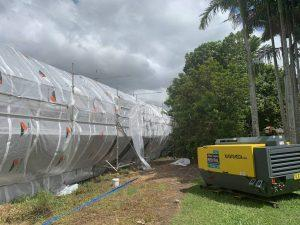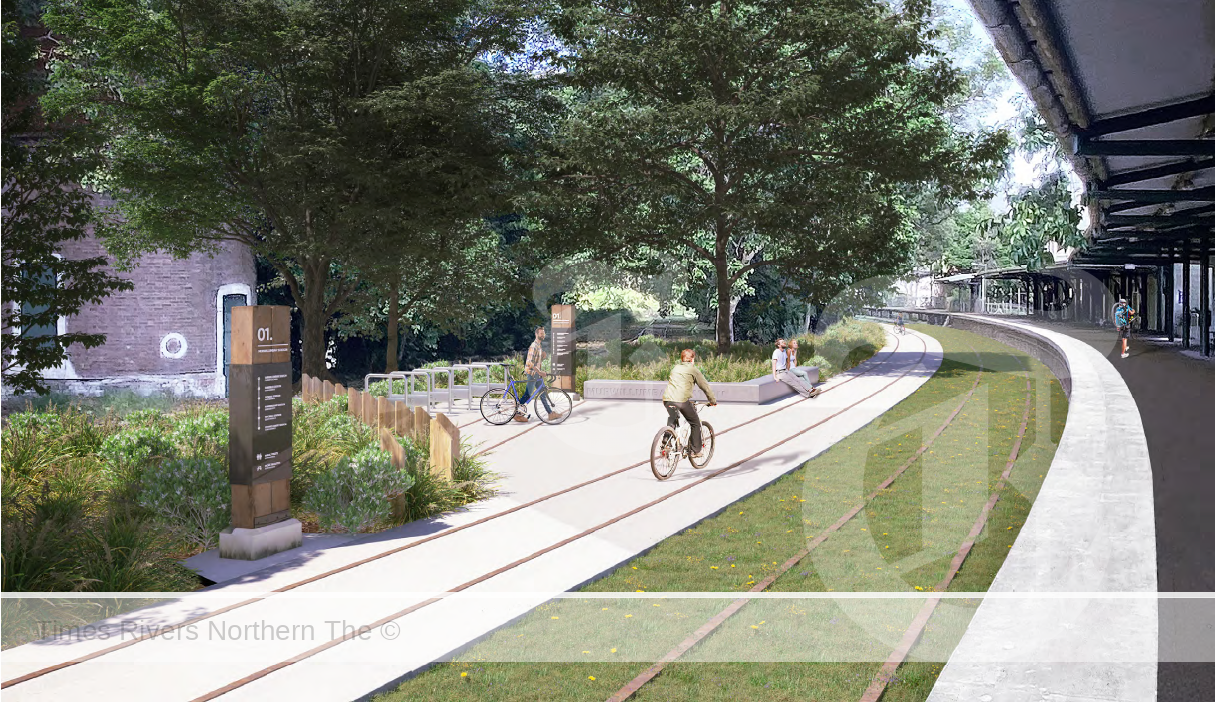Full steam ahead for Tweed section of Rail Trail
Construction work shifts up a gear on Northern Rivers Rail Trail
Anticipation is building for local businesses, cycle enthusiasts and walking groups after crews started construction works at a number of locations along the Tweed section of the Northern Rivers Rail Trail.
Thanks to input from industry experts and stakeholders including traditional owners, local residents, businesses, community and interest groups, the trail’s construction will see heritage bridges and railway station buildings restored, local places of cultural significance acknowledged and celebrated, and will deliver an accessible community resource for people of all abilities to enjoy.

Work has begun to restore the steelwork on the Colin Street Bridge at South Murwillumbah.
Project Director Iain Lonsdale said construction works on the Tweed section of the Northern Rivers Rail Trail were progressing well and on schedule to be finished by December next year.
Work to clear vegetation along the Tweed section of the trail began earlier this year while detailed design and preliminary site works have been underway since the $11.8m construction contract was awarded to family-owned construction company Hazel Bros in June.
“We are excited to be moving into the onsite construction phase of works now that the detailed site design works are nearly complete,” Mr Lonsdale said.
“Murwillumbah locals may have seen the main site office set up at the Murwillumbah Station in recent days and people may start to see crews preparing for the first construction works, set to begin at Dunbible on 15 December.”
The first official works will include restoration and resurfacing of the historic Colin Street Bridge in South Murwillumbah. A compacted gravel surface will also be installed along a 200 metre stretch of the disused rail line to trial the installation process and evaluate the surface’s suitability for local conditions. As part of this process, a section of the old railway track will be removed to enable construction of the new surface.
“It is really important to us that we respect our Aboriginal heritage and our built environment and I am proud this project will restore so much of this important local history and put it on show for people to enjoy and learn more,” Mr Lonsdale said.
Excitement building
Council’s Senior Economic Development Officer Kym Kranen is looking forward to the project getting underway.
“The Rail Trail will be a fantastic resource for our community and make the Tweed an even greater place to visit, helping our local businesses to thrive,” she said.
“It will be a destination for the whole community to enjoy – whether you want a safe place to ride with friends and family, go on a long distance ride with your cycle club, or just walk through the countryside to explore local villages, experience our beautiful scenic landscapes or learn about local history.”
When completed, the Northern Rivers Rail Trail will preserve the 132km scenic rail corridor between Murwillumbah and Casino, creating a safe, car-free connection between the villages and towns along the route.
The 24km Tweed section will link Murwillumbah Railway Station with the Tweed Regional Gallery and travel south through the villages of Stokers Siding, Burringbar, Mooball and Crabbes Creek.
“The Rail Trail will be a wonderful backdrop for a whole host of new eco-tourism ventures,” Ms Kranen said.
“We think it is really going to be something special and we’re excited about the ideas we’re already hearing from the local business community. They are really excited too – a workshop for local entrepreneurs and business operators hosted by Destination North Coast this week was booked out.”
Ms Kranen said some of the ideas at the workshop included coffee vans and kiosks, food trucks, paddock-to-plate experiences, horse-riding, arts and crafts stalls and brewery and distillery tours.
The Australian Government’s Regional Jobs and Infrastructure Package Fund and NSW Government’s Restart NSW program have provided the funding required to construct the trail.
Train services ceased operating on the Northern NSW Branch Line between Casino and Murwillumbah in May 2004 and the NSW Government formally closed the line in October 2020.
To learn more and let us know your thoughts about how we can make the most of this new community resource, or to register your business interest, visit yoursaytweed.com.au/railtrail.





 Tweed Shire News2 years ago
Tweed Shire News2 years ago
 Motoring News2 years ago
Motoring News2 years ago
 COVID-19 Northern Rivers News3 years ago
COVID-19 Northern Rivers News3 years ago
 COVID-19 Northern Rivers News3 years ago
COVID-19 Northern Rivers News3 years ago
 Northern Rivers Local News3 years ago
Northern Rivers Local News3 years ago
 Health News3 years ago
Health News3 years ago
 COVID-19 Northern Rivers News3 years ago
COVID-19 Northern Rivers News3 years ago
 NSW Breaking News3 years ago
NSW Breaking News3 years ago


























